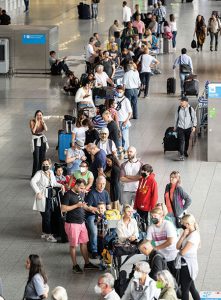Bloomberg
The share of US flight delays caused by airlines, as opposed to weather or air traffic control, has surged to the highest level on record, reflecting carriers’ struggle in the post-Covid rebound.
Through April, airlines triggered about 58% of late flights so far in 2022, surpassing those that were tardy due to storms, the government’s air-traffic system and security glitches, according to data reviewed by Bloomberg News.
Airlines acknowledge struggling with a “Covid hangover†as demand for travel surged and they attempted to bring on and retrain employees to replace those who had gone on leave or left. But they say they have no incentive to delay flights, and that factors such as bad weather and similar issues with the nation’s air-traffic system have also contributed.
“Our entire nation is still coming out of Covid and coping with Covid, and so there are plenty of challenges to go around,†said Sharon Pinkerton, senior vice president of the trade group Airlines for America. “We all have issues. That’s why we need to work together and collaborate on solutions.â€
Transportation Secretary Pete Buttigieg has repeatedly called on the airlines to address delays and cancellations.
“We’ve seen movement in the right direction†he said on Fox News. The agency declined to comment on the delay causes.
In some cases, airlines intentionally delay flights to ensure passengers make connections and to limit broader disruptions, Pinkerton said. Internal airline data show that the system has been functioning more smoothly in recent weeks, she said. All six of the largest US carriers have trimmed their summer schedules to reduce disruptions.
“All of this turmoil is unprecedented, but we’re coming out of it because of the actions that we’re taking,†Pinkerton said.
And it isn’t only in the US. In the UK, London’s Heathrow Airport imposed passenger limits because it couldn’t handle the surge in summer travellers. Delta Airline Lines Inc used an empty wide-body plane to fly lost luggage to back to the US.
Carriers have been saying for months that staffing issues at FAA air-traffic facilities have contributed to the problem and the data indicate there’s some truth to that. Delays attributed to the “National Aviation System†— a broad category that includes weather issues and the FAA system’s capacity limits — at Miami International Airport grew to 3,668 through April this year, almost four times higher than the same period in 2019.
Historically, delays attributed to the aviation system have hovered slightly above those caused by airlines, but that trend has reversed since the pandemic.
 The Gulf Time Newspaper One of the finest business newspapers in the UAE brought to you by our professional writers and editors.
The Gulf Time Newspaper One of the finest business newspapers in the UAE brought to you by our professional writers and editors.
